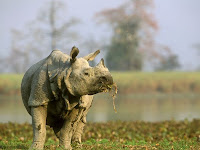One more species, that is very rare in the world now, is a huge weighted, giant beast -- Rhinoceros
Rhinos once roamed Europe, Asia and Africa and were known by early Europeans who depicted them in cave paintings. In historical times, rhinos were still widespread in the African savannas and the tropical forests of Asia.
Today, very few rhinos survive outside national parks and reserves. Rhinos are threatened by poaching due to the demand for their horns, and habitat loss, a result of human populations encroaching on the land and the destruction of forests. WWF works to strengthen protected areas in Africa and Asia and stop illegal trade of rhino horns.
The southern white rhino, once thought to be extinct, and the Indian rhino are thriving in well-protected sanctuaries and their numbers are increasing. Black rhino populations have increased too, but total numbers are still a fraction of what they were fifty years ago.
Rhinoceroses are universally recognized because of their massive bodies, short legs and one or two horns. In some rhino species the horn is small and not easily visible. Rhinos have poor eyesight, but their sense of smell and hearing are well developed.
Five species of rhinos
Black Rhinoceros
Scientific Name: Diceros bicornis
Habitat: tropical and subtropical grasslands, savannas and deserts
Location: East, Central, West and South Africa
Population: approximately 3,725 individuals
Sumatran Rhinoceros
Scientific Name: Dicerorhinus sumatrensis harrissoni
Habitat: lowland swamps and forests with thick vegetation
Location: northern Borneo. Borneo is the third largest island in the world, located north of Australia. The island is made up of the countries of Malaysia, Indonesia and Brunei.
Population: Fewer than 25
Indian Rhinoceros
Common Name: Indian rhino, greater one-horned rhinoceros; Rhinocéros unicorne de l'Inde (Fr); Rinoceronte unicornio índico (Sp)
Scientific Name: Rhinoceros unicornis
Habitat: Tropical and Subtropical Grasslands, Savannas, and Shrublands
Location: Southern Asia, northern margin of the Indian subcontinent adjacent to the southern slope of the Himalayas
Population: Around 2,400 individuals
Javan Rhinoceros
Common Name: Javan rhinoceros, lesser one-horned rhino
Scientific Name: Rhinoceros sondaicus
Habitat: Tropical and Subtropical Moist Broadleaf Forests
Location: Western Indonesia, Eastern Indochina
Population: 40-60 in Ujung Kulon National Park, Java, Indonesia; no more than 8 in Cat Tien National Park, Vietnam
Rhinos once roamed Europe, Asia and Africa and were known by early Europeans who depicted them in cave paintings. In historical times, rhinos were still widespread in the African savannas and the tropical forests of Asia.
Today, very few rhinos survive outside national parks and reserves. Rhinos are threatened by poaching due to the demand for their horns, and habitat loss, a result of human populations encroaching on the land and the destruction of forests. WWF works to strengthen protected areas in Africa and Asia and stop illegal trade of rhino horns.
The southern white rhino, once thought to be extinct, and the Indian rhino are thriving in well-protected sanctuaries and their numbers are increasing. Black rhino populations have increased too, but total numbers are still a fraction of what they were fifty years ago.
Rhinoceroses are universally recognized because of their massive bodies, short legs and one or two horns. In some rhino species the horn is small and not easily visible. Rhinos have poor eyesight, but their sense of smell and hearing are well developed.
Five species of rhinos
Black Rhinoceros
Scientific Name: Diceros bicornis
Habitat: tropical and subtropical grasslands, savannas and deserts
Location: East, Central, West and South Africa
Population: approximately 3,725 individuals
Sumatran Rhinoceros
Scientific Name: Dicerorhinus sumatrensis harrissoni
Habitat: lowland swamps and forests with thick vegetation
Location: northern Borneo. Borneo is the third largest island in the world, located north of Australia. The island is made up of the countries of Malaysia, Indonesia and Brunei.
Population: Fewer than 25
Indian Rhinoceros
Common Name: Indian rhino, greater one-horned rhinoceros; Rhinocéros unicorne de l'Inde (Fr); Rinoceronte unicornio índico (Sp)
Scientific Name: Rhinoceros unicornis
Habitat: Tropical and Subtropical Grasslands, Savannas, and Shrublands
Location: Southern Asia, northern margin of the Indian subcontinent adjacent to the southern slope of the Himalayas
Population: Around 2,400 individuals
Javan Rhinoceros
Common Name: Javan rhinoceros, lesser one-horned rhino
Scientific Name: Rhinoceros sondaicus
Habitat: Tropical and Subtropical Moist Broadleaf Forests
Location: Western Indonesia, Eastern Indochina
Population: 40-60 in Ujung Kulon National Park, Java, Indonesia; no more than 8 in Cat Tien National Park, Vietnam
Previous Post : Tiger-Somewhat back from 'low' now





No comments:
Post a Comment